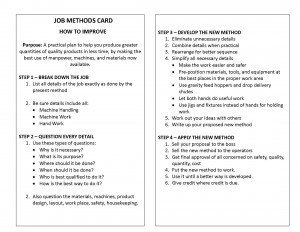Most of us familiar with Training Within Industry know that the majority of the training in TWI has been in the area of Job Instruction. When we think about Sales, we immediately think about Job Relations. I think TWI offers a greater opportunity. We spend most of our time training sales and support people to introduce our product and service to our customer. Job Methods is without question the most underused component of the J-programs. I believe that it was originally developed for the Industrial Engineer to sell their ideas to management and operations. What about using JM for sales to construct the message from the customer into our development and/or operations? What about having an effective Lean way to bring the message in?
But before I start there, I would like to mention one thing…Lean is built on the the tenant of only doing “What the Customer Values”. This is the predominant thought of Lean. If you are a Lean organization feedback from the customer should be of primary importance. The most important part of delivering this message is to provide accurate and timely information. Waiting for the next focus group or survey is not what you are after. The development of an iterative process relies on smaller iterations and generating more frequent reviews. I would say that having a mechanism developed to post and gather feedback that is visually displayed would go a long way in bringing the message in.
I do realize that sometimes it is not that simple. Most companies/people do not take feedback well. We can go over all the issues with performance reviews for example but the approach and the willingness to take feedback is essential for the growth of companies. This may sound a little overboard mentioning using TWI as the instrument to bring the message into operations, but I think it provides a very “Lean” method for doing it.
Suggestions when using the Job Methods card:
Step 1 & 2: Refine the idea and shape your pitch (I don’t think pitch is a bad word): You must think about execution and delivery .
Step 3: Frame it in their perspective and be able to explain it well. Often, I will start with a paragraph and break it down into one or two sentences and then to one or two words. The next step is to determine whom this idea will affect and who will be most interested. You will need to address both of these components, but I think building constituency around an idea is important. You also need to throw a few trial balloons out there to help in the delivery of it
Step 4: Deliver the information to the concerned parties.
Another suggestion I would have is staying away from starting with a negative connotation. I would say something like, “The customer really likes what we are doing”. Then lead into, “They would really like to do this, and this is how they explained it”. With that said, you need to do your homework and make sure that this is within the capability of your company and would lead to a profitable venture. It is up to you to look at both points of view.
Lean Sales and Marketing: Learn about using CAP-Do

